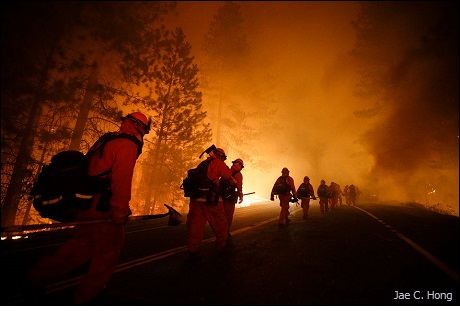
|
|

|
|
| April 27, 2024 |
|
California is paying inmates $1 an hour to fight wildfires 
SACRAMENTO--Since the Mendocino Complex Fire began on July 27th, nearly 350,000 acres of northern California have been scorched, making the blaze the largest fire in the state's history. As of Monday, 146 homes have been destroyed and more than 1,000 buildings remain in peril.
There are roughly 14,000 firefighters on duty battling fires across the region. Among them are more than 2,000 inmates. The inmates are part of a volunteer firefighting program run by the California Department of Corrections and Rehabilitation (CDCR). They're paid $2 a day, and $1 an hour when fighting an active fire. They also earn time off their sentences. "Each volunteer inmate is evaluated individually to ensure that all those selected for the camp program are willing to be team members with nonviolent behavior, even if their original conviction was for a violent crime," CDCR representative Vicky Waters tells CNBC Make It. Volunteers must have "minimum custody" status and are not considered if they have committed arson, rape or sex offenses or if they have any active warrants or medical issues. The inmate volunteers live in "conservation camps" and do physical labor like cutting brush and trees to reduce fire danger, clearing flood channels and storm drains and maintaining hiking trails. The program dates back to 1915, when the CDCR first established labor camps that forced inmates to build highways and roads. The program was expanded during World War II and by 1945, the first inmate firefighting program was established. Today, the CDCR, CAL FIRE and the Los Angeles County Fire Department jointly operate 43 adult conservation camps in 27 countries, with about 3,400 inmates participating in total. According to the CDCR, the program saves the state between $90 and $100 million a year, though some critics fear that the financial benefits of cheap prison labor incentivize mass incarceration. Gayle McLaughlin, who is currently running for California Lieutenant Governor, went so far as to call the program "slave labor." Still, the CDCR maintains that the program helps both the state and the inmates. "The fire camp program helps inmates build skills in firefighting, including positively working in a team environment," says Waters. "It can be an important part of an inmate's rehabilitation while they are serving their sentences with CDCR." While some work programs have been known to decrease recidivism and improve outcomes after incarceration, programs like these rarely lead to firefighting jobs once inmates are released. Most fire departments, Axios reports, require firefighters to be a licensed EMT, and EMT certifying boards typically deny applicants with criminal history. And many have critiqued programs like these for putting inmates in harm's way. Just like full-time civilian firefighters, inmate firefighters face serious risk when performing tasks like creating containment lines. According to NPR, six firefighters have lost their lives battling the wildfires in this region in recent weeks. "When prisoners do volunteer to work, it's especially important that we make absolutely sure that they're making a free and uncoerced and truly voluntary choice," David Fathi, director of the ACLU's National Prison Project, tells WBUR. "That's especially important when the work they're doing is very dangerous, like fighting wildfires." (Source: CNBC) Story Date: August 20, 2018
|